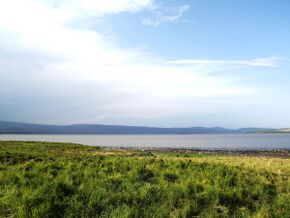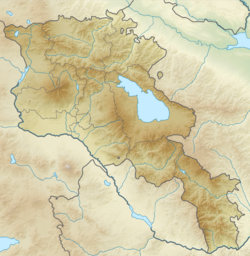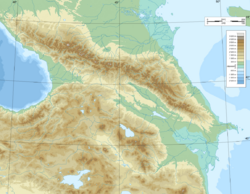Earth:Lake Arpi
| Lake Arpi | |
|---|---|
 | |
| Location | Shirak Province, Armenia |
| Coordinates | [ ⚑ ] : 41°03′0″N 43°37′00″E / 41.05°N 43.6166667°E |
| rivers, streams, precipitation">Primary inflows | Streams and meltwater |
| rivers, streams, evaporation">Primary outflows | Akhurian River |
| Basin countries | Armenia |
| Surface area | 20 km2 (7.7 sq mi) |
| Average depth | 4.2 m (14 ft) |
| Max. depth | 8 m (26 ft) |
| Water volume | 90,000 km3 (22,000 cu mi) |
| Surface elevation | 2,025 m (6,644 ft) |
| Designated | 7 June 1993 |
| Reference no. | 621[1] |
Lake Arpi (Armenian: Արփի լիճ, romanized: Arp’i lich; Turkish: Arpa Göl[2]) is a lake and reservoir located in the Shirak Province of Armenia, on the Ashotsk plateau in the northwestern part of the country. It sits at an altitude of 2,025 m with an area of 20 km2. It is the source of the Akhurian River.[3][4]
Lake Arpi originated from a volcano tectonic earthquake. In 1946–1950, the Arpi Dam was built on the Akhurian River, artificially increasing the size of the lake.[3] The reservoir's dam, made of reinforced concrete, is 10 m high and 80 m long.[5] Prior to the construction of the dam, the lake had a surface area of 4.5 km2, volume of 5 million cubic meters, and was 1.6 m deep. The reservoir-lake is 7.3 km long and 4.3 km wide, with a surface area of 20 km2, an average depth of 4.2 m (maximum 8 m), and a volume of 90 million cubic meters (about 19 times more than the natural lake).[3] Its maximum capacity is 105 million cubic meters.[5] During the winter, it is usually completely covered by ice․[3][5] The lake is fed by meltwater[6] and several springs and streams (Karmrajur, Yeghnajur, Elar, etc.).[4] The reservoir is used for irrigation and hydropower production, irrigating farmlands in the plain of Shirak and the basin of the Upper Akhurian. The Talin and Armavir canals receive additional water from Lake Arpi.[5]
The lake has rich flora and fauna. It was designated a Ramsar site in 1993,[1] and a national park was established around the lake in 2009.[7] More than 140 species of bird have been observed around the lake, of which 80–85 were nesting.[6] It hosts the largest colony of Armenian gull in the world;[6] pelicans and different species of ducks and migrating birds can also be seen there.[5] The area is recognized as an Important Bird Area.[8] Eurasian otters and water voles come to the reservoir via the Akhurian.[4][5] Cyprinus and Varicorhinus inhabit its waters,[3] among other species of fish.[9] The total number of species of fish increased after the lake was turned into a reservoir.[9] The lake is used for fish farming and fishing.[5] In recent years, man-made factors have negatively affected the lakes ecology. Poaching and the use of unauthorized fishing methods have decreased the total population of fish, while periodic changes in the water level have been noticed.[9]
Lake Arpi can be reached by road from the east from Ghazanchi or from the south from Amasia.[6] Small boats are used to traverse the lake.[5]
References
- ↑ 1.0 1.1 "Lake Arpi". 1 January 2011. https://rsis.ramsar.org/ris/621?language=en.
- ↑ Lynch, H. F. B. (2020). Armenia, Travels and Studies, Volume 1 (1 ed.). Frankfurt am Main: Outlook Verlag GmbH. p. 422. ISBN 9783752410174. https://books.google.com/books?id=yHP1DwAAQBAJ&q=arpa+g%C3%B6l. Retrieved 16 July 2022.
- ↑ 3.0 3.1 3.2 3.3 3.4 Hakobyan, T. Kh.; Melik-Bakhshyan, St. T.; Barseghyan, H. Kh. (1986). "Arpʻi" (in hy). Hayastani ev harakitsʻ shrjanneri teghanunneri baṛaran. I. Yerevan State University Publishing House. pp. 514. http://nayiri.com/imagedDictionaryBrowser.jsp?dictionaryId=61&dt=HY_HY&pageNumber=546.
- ↑ 4.0 4.1 4.2 Poghosyan, A. (1976). "Arpʻi lchi jrambar". in Hambardzumyan, Viktor (in hy). Haykakan sovetakan hanragitaran. 2. Yerevan: none. pp. 155. https://hy.wikisource.org/wiki/%D4%B7%D5%BB:%D5%80%D5%A1%D5%B5%D5%AF%D5%A1%D5%AF%D5%A1%D5%B6_%D5%8D%D5%B8%D5%BE%D5%A5%D5%BF%D5%A1%D5%AF%D5%A1%D5%B6_%D5%80%D5%A1%D5%B6%D6%80%D5%A1%D5%A3%D5%AB%D5%BF%D5%A1%D6%80%D5%A1%D5%B6_(Soviet_Armenian_Encyclopedia)_2.djvu/155.
- ↑ 5.0 5.1 5.2 5.3 5.4 5.5 5.6 5.7 Ayvazyan, H. M., ed (2006) (in hy). Hayastani bnashkharh hanragitaran. Yerevan: Armenian Encyclopedia Publishing House. pp. 146. ISBN 5-89700-029-8.
- ↑ 6.0 6.1 6.2 6.3 Holding, Deirdre (2014), Armenia with Nagorno Karabagh: The Bradt Travel Guide (4th ed.), Guilford, Connecticut: The Globe Pequot Press, pp. 233–234, ISBN 978-1-84162-555-3, https://archive.org/details/armeniawithnagor0000hold
- ↑ "Arpʻi lich" (in hy). https://www.armgeo.am/lake-arpi/.
- ↑ "Important Bird and Biodiversity Areas - IBAs of Armenia". 2015. http://www.abcc-am.org/iba.html.
- ↑ 9.0 9.1 9.2 Pipoyan, S. Kh.; Malkhasyan, A. H. (2014). "Hayastani petakan argelotsʻneri ev azgayin parkeri dzknashkharhě" (in hy). Biological Journal of Armenia 66 (1): 22–23. https://arar.sci.am/dlibra/publication/260072/edition/238145/content.
 |



